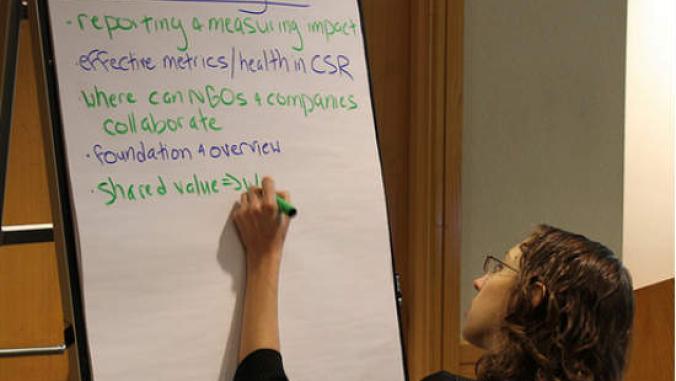5 best practices to green healthcare
Hospital food is just one part of the problem, as well as one of a handful of powerful solutions, to make medical care sustainable.

What percentage of total greenhouse gas emissions are related to the healthcare industry? The answer highlights why the greening of healthcare is a serious business: U.S. hospitals contribute 8 percent of our total carbon footprint, creating 2 million tons of waste annually.
“Sustainability is preventative medicine on a grand scale,” said Kathy Gerwig, vice president of employee safety, health and wellness at Kaiser Permanente.
The environmental stewardship officer was speaking in a keynote recently to over 100 environmental health specialists, nurses, medical students and sustainability practitioners at the University of California, San Francisco’s Mission Bay Campus. To explore the link between sustainability and healthcare, each speaker also provided actionable steps healthcare institutions can take.
A key message: Sustainability is not only good for the planet and the pocketbook, but it also supports total health.
Kaiser Permanente’s sustainability strategy focuses on five key areas: climate and energy; safer chemicals; water conservation; sustainable food; and waste reduction.
For those just getting started, Gerwig recommended, “As you look across your facilities, prioritize worker and patient safety and cost savings.” Based on this advice and the many topics covered at the workshop, here are five best practices to consider:
1. Start a reprocessing program
Here is a fact that should make hospital administrators pay attention: According to Gerwig, over the past 10 years, Kaiser Permanente has saved over $55 million from its reprocessing program alone. For fiscal year 2014-2015, through partnerships with Hygia, Masimo and Stryker, single-use devices collected in the surgery department, electrophysiology lab and patient rooms for reprocessing saved UCSF over $1 million. It makes me wonder why every hospital and medical center has not jumped on this best practice. Gerwig stressed, “Greening is not more expensive for us — it is a myth that it costs more.”
2. Buy safer cleaning products
Registered nurse Vickie Leonard gave an overview of toxins and the impact on human health. Her talk, “Health Effects of Chemical Exposures During Pregnancy and Early Childhood” (PDF), warned that commonly used products such as cleaners, sanitizers and disinfectants can pose health risks to the fetus and young children.
In the afternoon breakout panel on green teams, Barbara Sattler, a nurse and University of San Francisco professor of public health with the Alliance of Nurses for Healthy Environments, also warned about the health impact of chemical exposures in hospitals, which can trigger adult-onset asthma in nurses and janitors.
Leonard’s best tip for choosing safer products that pose fewer health risks to these vulnerable populations, as well as to the environment, is to buy Green Seal certified cleaning products. These greener products are better for both staff and patients. She also urged participants to avoid triclosan, used for hand washing in hospital, because studies show it doesn’t work better than soap and water.
“All risk and no benefit,” she warned.
3. Purchase meat without antibiotics and serve less meat
Tom Newman, professor of epidemiology & biostatistics and pediatrics at UCSF, kicked off his talk, “Should Hospitals Serve Meat?” (PDF), with this reminder: Not many years ago, it was a big fight to ban smoking in hospitals. Today, he considers improving the quality of hospital food to be the next movement. He urged hospitals to consider the environmental, social and health implications of its food purchasing.
Both UCSF and Kaiser Permanente have programs in place to encourage purchasing local, healthy food. Newman spoke of the health and environmental benefits of eating more plants and less meat, as well as provided an overview of the dangers of using antibiotics in livestock. UCSF has increased sustainable food purchasing from 9 percent to 26 percent over the past five years and launched a program to purchase antibiotic-free meat.
You might be surprised to learn that 80 percent of antibiotics aren’t used to treat illnesses in people; but rather are fed to livestock such as cows, pigs, turkeys and chickens for non-therapeutic purposes, creating antibiotic-resistant “superbugs.”
4. Purchase flame-retardant-free furniture
Kaiser Permanente spends big dollars on furniture — $25 million to 30 million per year, according to Gerwig. “We will no longer buy products with flame retardants,” she said.
Kaiser has promoted this program to others, creating a movement that spends about $50 million per year. The Center for Environmental Health's new e-guide lists manufacturers with flame-retardant free furniture. Here are tips to minimize exposure to flame retardants.
5. Talk about climate change as a health issue
Linda Rudolph, co-director of the Climate Change and Public Health Project, the Public Health Institute, spoke passionately about the health impacts associated with climate change (PDF). Smoke from wildfires, increased ozone and dust, a longer pollen season, urban heat islands, vector-borne illnesses and drought all affect the health of the most vulnerable — the elderly and the young.
“You have credibility,” she urged the audience. “Talk to others — friends, colleagues, neighbors and leaders — about climate change as a health issue and call for strong climate solutions. Join the US Climate and Health Alliance.”





